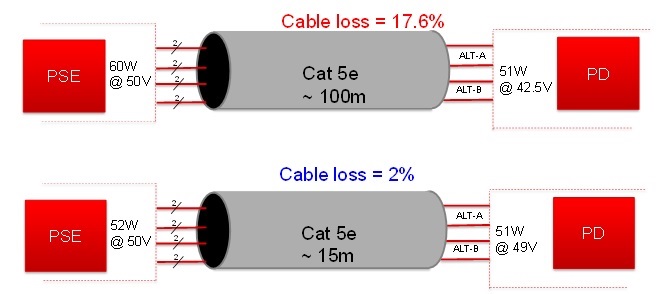SSZTBQ6 january 2016
Power over Ethernet (PoE) offers a convenient approach to deliver electrical power through Ethernet cables, eliminating the need for other external power sources and separate power cabling for equipment connected in an Ethernet network.
One limitation of the current IEEE802.3at standard is that the powered device (PoE PD) is not allowed to consume more than 25.5W. Another is that power can be delivered only over two pairs, which results in cable loss and low overall system efficiency. As a result, many applications have so far been out of reach for PoE, including the lighting market.
However, once released, the IEEE802.3bt standard will be able to fix these shortcomings, while adding many more features that will enable the use of PoE for LED lighting applications.
Let’s first review why you should consider PoE for LED lighting applications:
- Low installation costs. At less than 60V, you may not need a licensed electrician.
- Easy plug and play. Because the light automatically turns on when the fixture is connected through a network cable, there’s no need to turn off breakers before installation, and you can check cabling/interconnections immediately.
- Flexibility. Easily install and relocate network lighting devices.
- Connected lighting. Each lighting fixture has an IP address, with intelligent lighting control capability. This enables the use of various sensors (occupancy, light detection) in each fixture.
- Achievable low standby power.
- The fixture’s electronic ballast is small. The ballast operates from centralized driver, which is the power sourcing equipment (PSE), providing isolated low voltage. This enables the use of a simple buck topology in the ballast.
What PoE luminaires will be most common?
Troffers, downlights and many others.
Now, let me give you some details on the IEEE802.3bt standard. As an active member of this committee, I can give you a short summary of the major changes from the current standard that will directly impact PoE lighting.
A first change concerns the maximum power that the load can consume. To address this, the committee created two new types, type 3 and type 4, to allow the PSE to source up to 60W and 90W (52V-57V), respectively. Combining these new types with power delivery over four pairs will result in even more power available at the PD end of the cable.The committee is also introducing a new concept called “extended power.”
What is it exactly and why is it useful?
An issue with the current standard is that the allocated PD input power is based on a worst-case maximum cable length, which is 100 meters. See Figure 1 below. The extended power concept solves this by allowing the PD to go beyond this limit, as long as it does not cause the PSE to source more than it allocated. This implies that the PD “knows” the cable resistance. System architectures where the Ethernet cables are very short can take advantage of this feature.
 Figure 1 Long Cable vs. Short Cable:
Efficiency Comparison
Figure 1 Long Cable vs. Short Cable:
Efficiency ComparisonA second change to the standard is about the standby power, which is related to the power signature that a PD must generate in order to maintain the PSE power. The maintain power signature (MPS) consists of a specific DC current amplitude, time duration and duty cycle. The big change with the next standard is about reducing the time duration and duty cycle considerably, which will dramatically reduce the average standby power, while the lights are off and data communication remains active. See Figure 2.
 Figure 2 Maintain Power
Signature
Figure 2 Maintain Power
SignatureA third change to the standard is about ensuring that lighting remains operational (or can quickly turn back on) independent of data communication. This results in more reliable operation. To achieve this, the committee has defined a new requirement for type 3 and type 4 PSEs to support the physical layer classification for any power level the PSE can support.
Fourth, the Autoclass feature will allow better power optimization by the PSE. Basically, it allows the PSE to set the power budget to the maximum PoE PD power through a power measurement, including the cable losses.
I’m seeking feedback from lighting industry leaders, system integrators, LED ballast manufacturers and potential PSE lighting switch manufacturers (endspan and midspans).
What do you think? Do any of the new features mentioned above pique your interest and why? Please comment below to share your thoughts.
Additional resources about:
- Tool download: PoE PD Efficiency Calculator tool
- System block diagram: Power-over-Ethernet (PoE)
- Power products: PoE Powered device (PD) products and PoE Power sourcing equipment (PSE) products